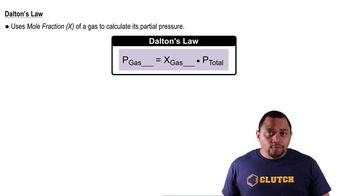Here are the essential concepts you must grasp in order to answer the question correctly.
Density of Gases
Density is defined as mass per unit volume. For gases, density can be expressed in grams per liter (g/L). The density of a gas can be calculated using the ideal gas law, which relates pressure, volume, temperature, and the number of moles of gas. Understanding how to manipulate this relationship is crucial for solving density-related problems.
Recommended video:
Partial Pressure and Dalton's Law
Dalton's Law states that in a mixture of gases, the total pressure is equal to the sum of the partial pressures of each individual gas. The partial pressure of a gas can be calculated by multiplying its mole fraction by the total pressure. This concept is essential for determining the contribution of each gas in a mixture to the overall density.
Recommended video:
Dalton's Law and Partial Pressure
Ideal Gas Law
The Ideal Gas Law is a fundamental equation in chemistry, expressed as PV = nRT, where P is pressure, V is volume, n is the number of moles, R is the ideal gas constant, and T is temperature in Kelvin. This law allows for the calculation of various properties of gases, including density, by rearranging the equation to solve for the desired variable. It is particularly useful in problems involving gas mixtures.
Recommended video:
 Verified step by step guidance
Verified step by step guidance


